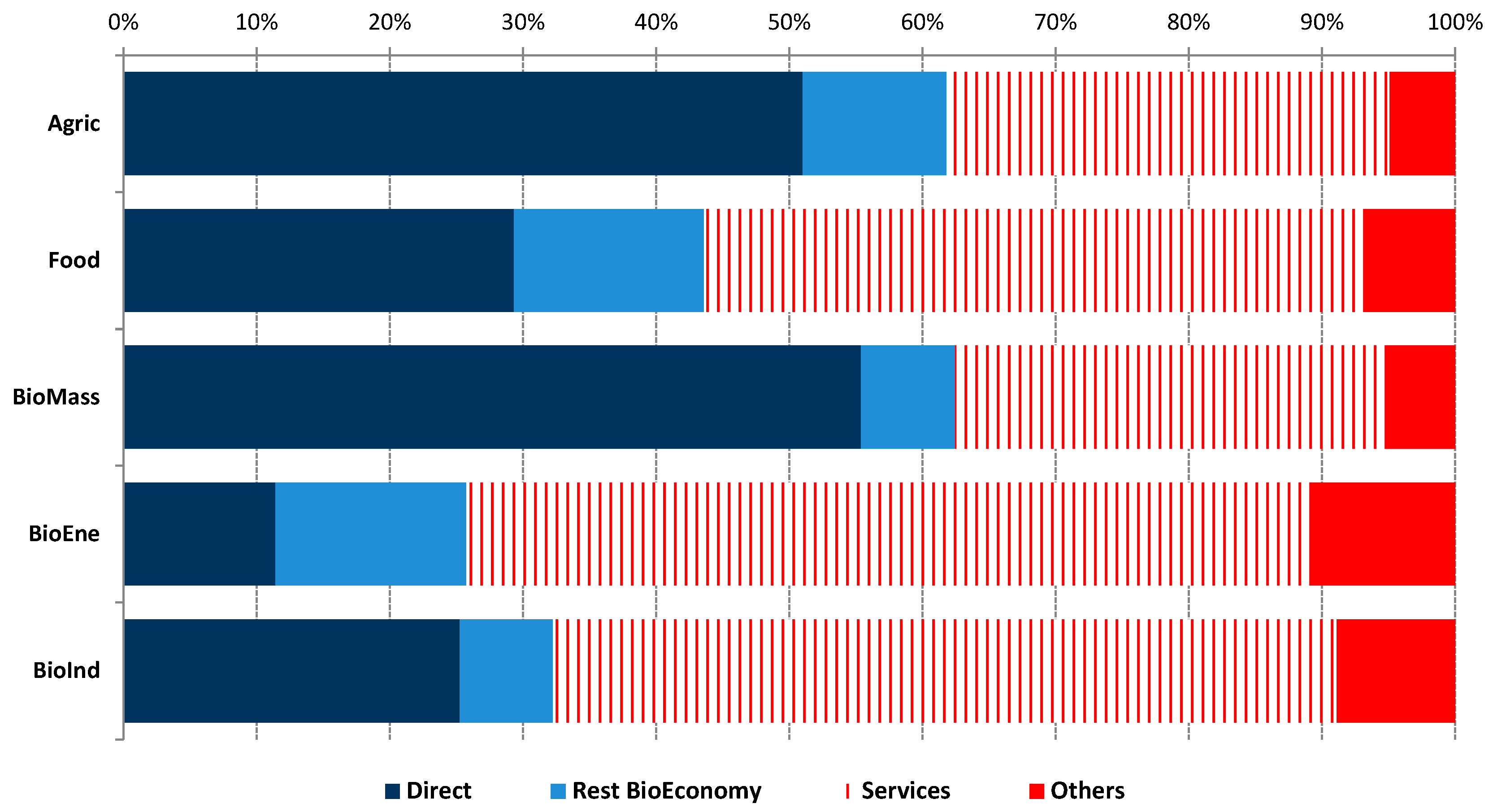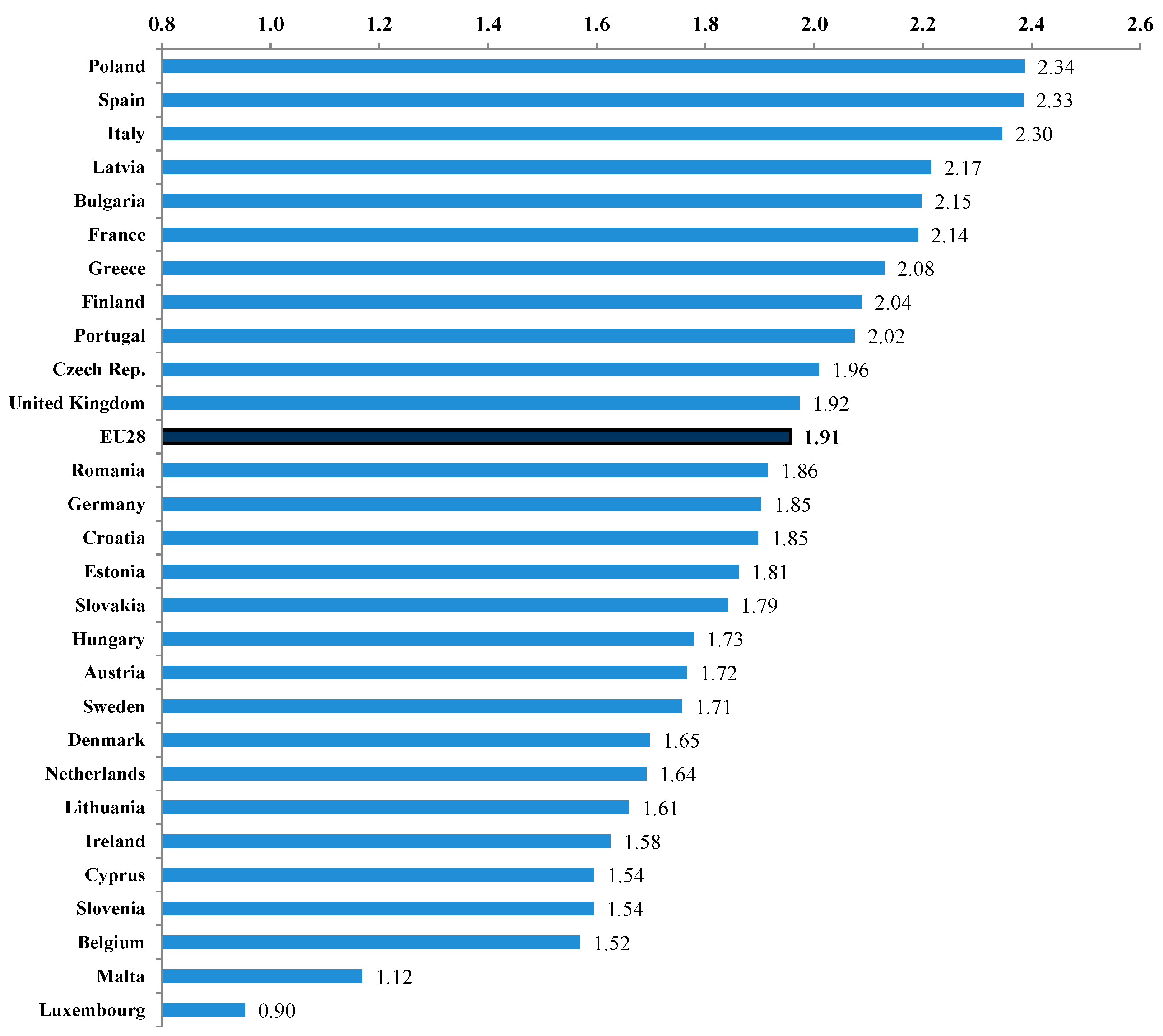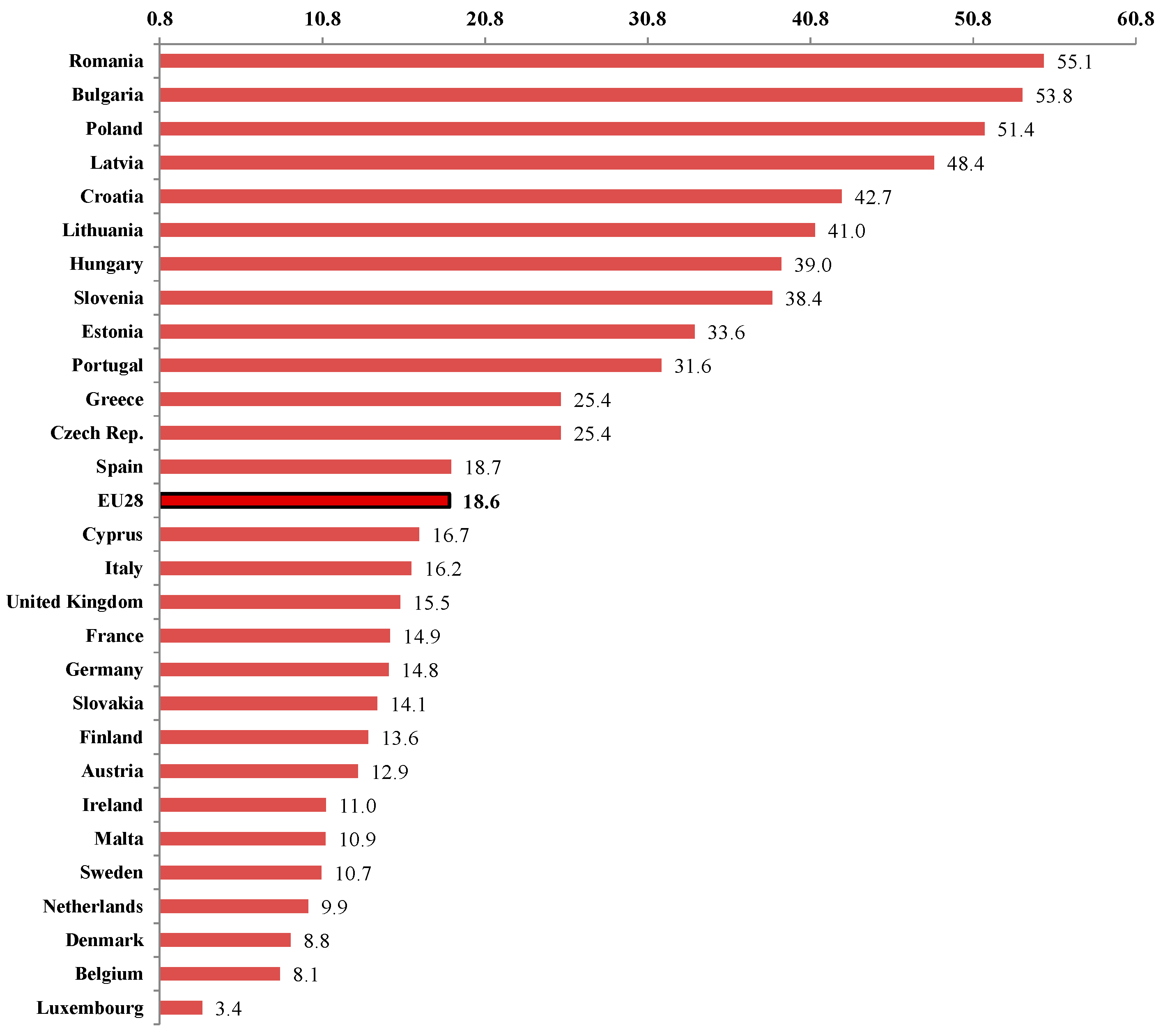The Role of Bioeconomy Sectors and Natural Resources in EU Economies: A Social Accounting Matrix-Based Analysis Approach
Abstract
:1. Introduction
2. Materials and Methods
2.1. Data Sources. The BioSAMs
2.2. Output and Employment Multipliers
3. Results
3.1. Bioeconomy Sectors in the EU28 Aggregate
3.2. Disaggregated Results of the Member States
4. Discussion and Conclusions
Acknowledgments
Author Contributions
Conflicts of Interest
References
- Boulding, K.E. The economics of the coming spaceship earth. In Environmental Quality in a Growing Economy; Jarrett, H., Ed.; John Hopkins University Press: Baltimore, MD, USA, 1966. [Google Scholar]
- Georgescu-Roegen, N. The Entropy Law and the Economic Process; Harvard University Press: Cambridge, MA, USA, 1971. [Google Scholar]
- Georgescu-Roegen, N. Bioeconomics, a New Look at the Nature of Economic Activity. In The Political Economy of Food and Energy; Junker, L., Ed.; Taylor & Francis: Boca Raton, FL, USA, 1977; pp. 105–134. [Google Scholar]
- Mengal, P.; Wubbolts, M.; Zika, E.; Ruiz, A.; Brigitta, D.; Pieniadz, A.; Black, S. Bio-based Industries Joint Undertaking: The catalyst for sustainable bio-based economic growth in Europe. New Biotechnol. 2018, 40, 31–39. [Google Scholar] [CrossRef] [PubMed]
- Bell, J.; Paula, L.; Dodd, T.; Németh, S.; Nanou, C.; Mega, V.; Campos, P. EU ambition to build the world’s leading bioeconomy—Uncertain times demand innovative and sustainable solutions. New Biotechnol. 2018, 40, 25–30. [Google Scholar] [CrossRef] [PubMed]
- McCormick, K.; Kautto, N. The Bioeconomy in Europe: An Overview. Sustainability 2013, 5, 2589–2608. [Google Scholar] [CrossRef]
- Fritsche, U.; Iriarte, L. Sustainability Criteria and Indicators for the Bio-Based Economy in Europe: State of Discussion and Way Forward. Energies 2014, 7, 6825–6836. [Google Scholar] [CrossRef]
- M’barek, R.; Philippidis, G.; Suta, C.; Vinyes, C.; Caivano, A.; Ferrari, E.; Ronzon, T.; Sanjuan-Lopez, A.; Santini, F. Observing and analysing the Bioeconomy in the EU: Adapting data and tools to new questions and challenges. Bio-Based Appl. Econ. 2014, 3, 83–91. [Google Scholar]
- Philippidis, G.; Sanjuán, A.I.; Ferrari, E.; M’barek, R. Employing social accounting matrix multipliers to profile the bioeconomy in the EU member states: Is there a structural pattern? Span. J. Agric. Res. 2014, 12, 913–926. [Google Scholar] [CrossRef]
- European Commission. Innovating for Sustainable Growth: A Bioeconomy for Europe. 2012. Available online: http://ec.europa.eu/research/bioeconomy/pdf/official-strategy_en.pdf (accessed on 10 November 2017).
- European Commission. Review of the 2012 European Bioeconomy Strategy. 2017. Available online: https://ec.europa.eu/research/bioeconomy/pdf/review_of_2012_eu_bes.pdf (accessed on 10 November 2017).
- Patermann, C.; Aguilar, A. The origins of the bioeconomy in the European Union. New Biotechnol. 2018, 40, 20–24. [Google Scholar] [CrossRef] [PubMed]
- Gobierno de España, Ministry of Economy and Competitiveness. The Spanish Bioeconomy Strategy 2030 Horizon. 2016. Available online: http://bioeconomia.agripa.org (accessed on 10 December 2017).
- Gouvernement de la France, Ministère de l’Agriculture et de l’Alimentation. Une Stratégie Bioéconomie Pour la France. 2017. Available online: http://agriculture.gouv.fr/ (accessed on 10 December 2017).
- Müller, M.; Perez-Dominguez, I.; Gay, S.H. Construction of Social Accounting Matrices for the EU27 with a Disaggregated Agricultural Sector (AgroSAM); JRC Scientific and Technical Reports; JRC 53558; European Commission-Joint Research Centre: Luxembourg, 2009. [Google Scholar]
- Cardenete, M.A.; Boulanger, P.; Delgado, M.; Ferrari, E.; M’Barek, R. Agri-food and bio-based analysis in the Spanish economy using a key sector approach. Rev. Urban Reg. Dev. Stud. 2014, 26, 112–134. [Google Scholar] [CrossRef]
- Mainar-Causapé, A.; Philippidis, G.; Sanjuan, A.I. Analysis of Structural Patterns in Highly Disaggregated Bioeconomy Sectors by EU Member States Using SAM/IO Multipliers; JRC Technical Reports; EUR 28591; European Commission-Joint Research Centre: Luxembourg, 2017. [Google Scholar]
- Stone, J.R. Input-Output and the Social Accounts. In The Structural Interdependence of the Economy, Proceedings of the International Conference on Input-Output Analysis, Varenna, Italy, 27 June–10 July 1954; Wiley: New York, NY, USA; Giuffre: Milan, Italy, 1955; pp. 155–172. [Google Scholar]
- Robinson, S. Multisector Models of Developing Countries: A Survey. In Handbook of Development Economics; Chenery, H.B., Srinivasan, T.N., Eds.; North-Holland: Amsterdam, The Netherlands, 1989; pp. 906–932. [Google Scholar]
- Roland-Holst, D.W.; Sancho, F. Relative Income Determination in the US: A Social Accounting Perspective. Rev. Income Wealth 1992, 38, 311–327. [Google Scholar] [CrossRef]
- Pyatt, G.; Round, J. Accounting and Fixed Price Multipliers in a Social Accounting Matrix. Econ. J. 1979, 89, 850–873. [Google Scholar] [CrossRef]
- Defourny, J.; Thorbecke, E. Structural Path Analysis and Multiplier Decomposition within a Social Accounting Matrix. Econ. J. 1984, 94, 111–136. [Google Scholar] [CrossRef]
- Robinson, S.; Roland-Holst, D.W. Macroeconomic Structure and Computable General Equilibrium Models. J. Policy Model. 1988, 10, 353–375. [Google Scholar] [CrossRef]
- Roland-Holst, D.W.; Sancho, F. Modeling Prices in a SAM Structure. Rev. Econ. Stat. 1995, 77, 361–371. [Google Scholar] [CrossRef]
- Rocchi, B. The CAP Reform Between targeting and Equity: A Structural Policy Analysis for Italy. Eur. Rev. Agric. Econ. 2009, 36, 175–202. [Google Scholar] [CrossRef]
- Arndt, C.; Jones, S.; Tarp, F. Structural characteristic of the economy of Mozambique: A SAM-based analysis. Rev. Dev. Econ. 2000, 4, 292–306. [Google Scholar] [CrossRef]
- De Miguel-Velez, F.J.; Perez-Mayo, J. Poverty Reduction and SAM Multipliers: An Evaluation of Public Policies in a Regional Framework. Eur. Plan. Stud. 2010, 18, 449–466. [Google Scholar] [CrossRef]
- Eurostat. Non-Financial Transactions (nasa_10_nf_tr). 2016. Available online: http://ec.europa.eu/eurostat/data/database (accessed on 15 November 2016).
- Eurostat. Supply, Use and Input-Output Tables (naio_10_cp). 2016. Available online: http://ec.europa.eu/eurostat/data/database (accessed on 15 November 2016).
- Aguiar, A.; Narayanan, B.; McDougall, R. An Overview of the GTAP 9 Data Base. J. Glob. Econ. Anal. 2000, 1, 181–208. [Google Scholar] [CrossRef]
- Britz, W.; Witzke, P. CAPRI Model Documentation. 2014. Available online: http://www.capri-model.org/docs/capri_documentation.pdf (accessed on 6 November 2017).
- Joint Research Centre. Jobs and Ministry of Economy and Competitiveness Turnover in the European Union Bioeconomy. 2017. Available online: http://datam.jrc.ec.europa.eu/datam/public/pages/datasets.xhtml (accessed on 15 November 2016).
- Byron, R.P. The Estimation of Large Social Account Matrices. J. R. Stat. Soc. Ser. A 1978, 141, 359–367. [Google Scholar] [CrossRef]
- Günlük-Senesen, G.; Bates, J.M. Some Experiments with Methods of Adjusting Unbalanced Data Matrices. J. R. Stat. Soc. Ser. A 1988, 141, 473–490. [Google Scholar] [CrossRef]
- McDougall, R. Entropy Theory and RAS Are Friends; GTAP Working Paper; Department of Agricultural Economics, Purdue University: West Lafayette, IN, USA, 1999. [Google Scholar]
- Robinson, S.; Cattaneo, A.; El-Said, M. Updating and Estimating a Social Accounting Matrix Using Cross Entropy Methods. Econ. Syst. Res. 2001, 13, 47–64. [Google Scholar] [CrossRef]
- Eurostat. Labour Force Survey (lfs_egan22d). 2016. Available online: http://ec.europa.eu/eurostat/data/database (accessed on 15 November 2016).
- Eurostat. Economic Accounts for Agriculture (aact_eaa01). 2016. Available online: http://ec.europa.eu/eurostat/data/database (accessed on 15 November 2016).
- Wiedmann, T. On the decomposition of total impact multipliers in a supply and use framework. J. Econ. Struct. 2017, 6, 11. [Google Scholar] [CrossRef]




| Broad Sector Code | Aggregated Sector Code | Description |
|---|---|---|
| Primary agriculture (Agric) | Cereal | Cereals (paddy rice, wheat, barley, maize, other cereals) |
| Veg | Vegetables (tomatoes, potatoes, other vegetables) | |
| Fruit | Fruits (grapes, other fruits) | |
| Oilseeds | Oilseeds (rape, sunflower, and soya seeds) | |
| OilPlant | Oil plants (olives, other oil plants) | |
| IndCrop | Industrial Crops (sugar beet, fiber plants, tobacco) | |
| OCrop | Other crops (live plants, other crops) | |
| ExtLiveProd | Extensive livestock production (live bovine; sheep, goats, horses, asses, mules…) | |
| IntLiveProd | Intensive livestock production (live swine, poultry) | |
| OliveProd | Other live animals and animal products | |
| RawMilk | Raw milk | |
| Fishing | Fishing | |
| Food processing (Food) | AnFeed | Animal feed, fodder crops 1, biodiesel by-product oilcake |
| RedMeat | Red meat (meat of bovine; meat of sheep, goats) | |
| WhMeat | White meat (meat of swine, poultry) | |
| VegOil | Vegetable oils | |
| Dairy | Dairy | |
| Rice | Rice, processed | |
| Sugar | Sugar, processed | |
| OliveOil | Olive oil | |
| Wine | Wine | |
| BevTob | Beverages and Tobacco | |
| OFoodProd | Other food products | |
| Bio-mass supply (BioMass) | EnergyCrops | Energy crops |
| Pellet | Pellets | |
| Forestry | Forestry, logging, and related service activities | |
| Bioenergy (BioEne) | BioElectricity | Bioelectricity |
| Biofuel1 | Biofuel 1st generation (bioethanol, biodiesel) | |
| Biofuel2 | Biofuel 2nd generation (biochemical and thermal technology biofuel) | |
| Bio-industry (BioInd) | Wood | Wood products |
| Textile | Textiles, wearing apparel and leather | |
| BioChem | Biochemicals | |
| Nonbio-based activity (NonBio) | NatRes | Natural resources (coal mining, petroleum, and coal, raw minerals) |
| Energy | Energy (electricity and gas) | |
| Manu | Manufactures | |
| Service | Services |
| Output Multipliers | Employment Multipliers | Output Multipliers | Employment Multipliers | ||||
|---|---|---|---|---|---|---|---|
| Agric | Cereal | 1.91 | 19.20 | Food | AnFeed | 2.09 | 24.59 |
| Veg | 1.58 | 23.19 | RedMeat | 2.13 | 23.08 | ||
| Fruit | 0.96 | 17.28 | WhMeat | 2.20 | 18.73 | ||
| Oilseeds | 1.70 | 16.33 | VegOil | 1.42 | 10.29 | ||
| OilPlant | 1.04 | 18.50 | Dairy | 1.97 | 14.53 | ||
| IndCrop | 1.18 | 28.92 | Rice | 1.87 | 22.23 | ||
| OCrop | 2.36 | 27.68 | Sugar | 1.59 | 13.39 | ||
| ExtLiveProd | 2.67 | 51.26 | OliveOil | 1.59 | 10.81 | ||
| IntLiveProd | 2.62 | 25.81 | Wine | 1.51 | 11.16 | ||
| OliveProd | 2.17 | 20.38 | BevTob | 1.91 | 13.88 | ||
| RawMilk | 2.53 | 31.52 | OFoodProd | 1.85 | 16.97 | ||
| Fishing | 1.64 | 15.55 | BioEne | Biofuel1 | 1.71 | 12.29 | |
| BioMass | Forestry | 2.15 | 24.37 | Biofuel2 | 2.11 | 15.37 | |
| EnergyCrops | 1.89 | 10.74 | BioElectricity | 1.97 | 11.72 | ||
| Pellet | 1.80 | 16.69 | BioInd | Textile | 1.40 | 13.11 | |
| Wood | 2.09 | 18.49 | |||||
| BioChem | 1.69 | 12.19 | |||||
| Agric | Food | BioMass | BioEne | BioInd | BioEcon | NonBio | |
|---|---|---|---|---|---|---|---|
| Austria | 1.93 | 1.63 | 1.84 | 1.82 | 1.71 | 1.72 | 1.86 |
| Belgium | 1.66 | 1.58 | 1.50 | 1.23 | 1.27 | 1.52 | 1.72 |
| Bulgaria | 2.57 | 1.93 | 2.55 | 1.45 | 1.76 | 2.15 | 2.12 |
| Croatia | 2.37 | 1.63 | 2.01 | 1.45 | 1.48 | 1.85 | 1.89 |
| Cyprus | 1.72 | 1.47 | 1.71 | 0.48 | 1.40 | 1.54 | 1.82 |
| Czech Rep. | 2.39 | 1.80 | 2.33 | 1.67 | 1.87 | 1.96 | 2.08 |
| Denmark | 1.96 | 1.59 | 1.85 | 1.27 | 1.27 | 1.65 | 1.71 |
| Estonia | 2.19 | 1.42 | 2.21 | 2.61 | 1.87 | 1.81 | 1.76 |
| Finland | 2.64 | 1.74 | 2.01 | 1.87 | 2.13 | 2.04 | 1.98 |
| France | 2.42 | 2.12 | 2.57 | 2.14 | 1.64 | 2.14 | 2.16 |
| Germany | 1.97 | 1.90 | 1.97 | 1.79 | 1.66 | 1.85 | 2.06 |
| Greece | 2.44 | 1.97 | 2.01 | 1.58 | 1.52 | 2.08 | 2.20 |
| Hungary | 2.13 | 1.57 | 1.98 | 1.49 | 1.19 | 1.73 | 1.60 |
| Ireland | 1.75 | 1.51 | 1.86 | 1.72 | 1.62 | 1.58 | 1.39 |
| Italy | 2.37 | 2.35 | 1.86 | 2.31 | 2.21 | 2.30 | 2.43 |
| Latvia | 2.15 | 1.65 | 2.67 | 1.67 | 2.46 | 2.17 | 2.26 |
| Lithuania | 2.01 | 1.47 | 1.93 | 1.34 | 1.38 | 1.61 | 1.75 |
| Luxembourg | 1.40 | 0.70 | 0.74 | 1.41 | 0.96 | 0.90 | 1.40 |
| Malta | 1.49 | 0.99 | 0.81 | 0.91 | 0.76 | 1.12 | 1.39 |
| Netherlands | 1.91 | 1.61 | 1.11 | 1.72 | 1.06 | 1.64 | 1.69 |
| Poland | 2.74 | 2.24 | 2.54 | 2.26 | 2.01 | 2.34 | 2.28 |
| Portugal | 2.36 | 1.97 | 2.22 | 2.03 | 1.90 | 2.02 | 2.26 |
| Romania | 1.26 | 2.13 | 2.73 | 2.30 | 2.06 | 1.86 | 2.50 |
| Slovakia | 2.18 | 1.44 | 2.50 | 1.89 | 1.61 | 1.79 | 1.97 |
| Slovenia | 1.91 | 1.55 | 1.80 | 1.75 | 1.32 | 1.54 | 1.86 |
| Spain | 2.43 | 2.43 | 2.24 | 2.16 | 1.88 | 2.33 | 1.93 |
| Sweden | 1.89 | 1.49 | 1.71 | 1.57 | 1.95 | 1.71 | 1.81 |
| United Kingdom | 2.45 | 1.84 | 2.84 | 2.24 | 1.62 | 1.92 | 2.32 |
| EU28 | 2.09 | 1.93 | 2.15 | 1.84 | 1.67 | 1.91 | 2.09 |
| Agric | Food | BioMass | BioEne | BioInd | BioEcon | NonBio | |
|---|---|---|---|---|---|---|---|
| Austria | 21.13 | 12.12 | 11.14 | 9.50 | 10.63 | 12.94 | 8.81 |
| Belgium | 10.58 | 8.13 | 9.75 | 5.05 | 6.59 | 8.14 | 6.32 |
| Bulgaria | 70.69 | 41.76 | 71.59 | 27.12 | 45.92 | 53.77 | 33.16 |
| Croatia | 62.99 | 32.40 | 55.08 | 24.67 | 32.05 | 42.68 | 24.78 |
| Cyprus | 24.28 | 11.92 | 41.74 | 5.30 | 16.41 | 16.70 | 11.80 |
| Czech Rep. | 32.35 | 20.79 | 34.00 | 17.39 | 27.26 | 25.40 | 18.85 |
| Denmark | 11.02 | 7.95 | 11.10 | 5.72 | 7.75 | 8.78 | 6.85 |
| Estonia | 46.48 | 25.39 | 40.77 | 33.49 | 32.97 | 33.64 | 17.18 |
| Finland | 23.23 | 11.18 | 12.20 | 8.19 | 12.23 | 13.57 | 9.46 |
| France | 18.33 | 14.16 | 17.51 | 12.54 | 11.32 | 14.91 | 10.73 |
| Germany | 18.13 | 14.93 | 17.70 | 11.96 | 12.41 | 14.81 | 11.95 |
| Greece | 34.57 | 21.53 | 35.35 | 13.42 | 15.59 | 25.41 | 19.71 |
| Hungary | 52.98 | 32.09 | 56.15 | 22.78 | 23.43 | 38.96 | 22.29 |
| Ireland | 30.01 | 7.97 | 11.50 | 6.29 | 6.14 | 10.96 | 4.94 |
| Italy | 21.07 | 15.33 | 30.32 | 11.51 | 14.96 | 16.22 | 13.35 |
| Latvia | 57.24 | 38.20 | 57.49 | 30.89 | 49.85 | 48.36 | 25.37 |
| Lithuania | 57.16 | 35.40 | 51.65 | 21.91 | 32.02 | 41.04 | 22.06 |
| Luxembourg | 10.87 | 2.21 | 1.37 | 2.81 | 2.43 | 3.37 | 2.89 |
| Malta | 17.07 | 8.07 | 4.25 | 6.06 | 7.60 | 10.94 | 7.40 |
| Netherlands | 12.60 | 9.11 | 8.06 | 8.17 | 6.61 | 9.88 | 6.30 |
| Poland | 70.88 | 46.41 | 59.53 | 35.63 | 37.94 | 51.44 | 30.35 |
| Portugal | 46.89 | 28.38 | 30.20 | 20.79 | 27.93 | 31.58 | 20.63 |
| Romania | 50.73 | 58.22 | 77.04 | 43.15 | 51.49 | 55.08 | 39.85 |
| Slovakia | 22.19 | 11.55 | 13.01 | 10.33 | 9.93 | 14.11 | 7.04 |
| Slovenia | 51.40 | 38.01 | 52.16 | 29.89 | 30.23 | 38.39 | 24.75 |
| Spain | 25.49 | 17.38 | 29.81 | 14.79 | 14.71 | 18.66 | 14.65 |
| Sweden | 14.17 | 9.61 | 10.20 | 8.03 | 11.18 | 10.69 | 7.27 |
| United Kingdom | 20.92 | 14.35 | 32.29 | 13.14 | 13.01 | 15.52 | 12.04 |
| EU28 | 26.48 | 17.08 | 24.26 | 12.65 | 14.52 | 18.57 | 17.80 |
© 2017 by the authors. Licensee MDPI, Basel, Switzerland. This article is an open access article distributed under the terms and conditions of the Creative Commons Attribution (CC BY) license (http://creativecommons.org/licenses/by/4.0/).
Share and Cite
Fuentes-Saguar, P.D.; Mainar-Causapé, A.J.; Ferrari, E. The Role of Bioeconomy Sectors and Natural Resources in EU Economies: A Social Accounting Matrix-Based Analysis Approach. Sustainability 2017, 9, 2383. https://doi.org/10.3390/su9122383
Fuentes-Saguar PD, Mainar-Causapé AJ, Ferrari E. The Role of Bioeconomy Sectors and Natural Resources in EU Economies: A Social Accounting Matrix-Based Analysis Approach. Sustainability. 2017; 9(12):2383. https://doi.org/10.3390/su9122383
Chicago/Turabian StyleFuentes-Saguar, Patricia D., Alfredo J. Mainar-Causapé, and Emanuele Ferrari. 2017. "The Role of Bioeconomy Sectors and Natural Resources in EU Economies: A Social Accounting Matrix-Based Analysis Approach" Sustainability 9, no. 12: 2383. https://doi.org/10.3390/su9122383
APA StyleFuentes-Saguar, P. D., Mainar-Causapé, A. J., & Ferrari, E. (2017). The Role of Bioeconomy Sectors and Natural Resources in EU Economies: A Social Accounting Matrix-Based Analysis Approach. Sustainability, 9(12), 2383. https://doi.org/10.3390/su9122383





